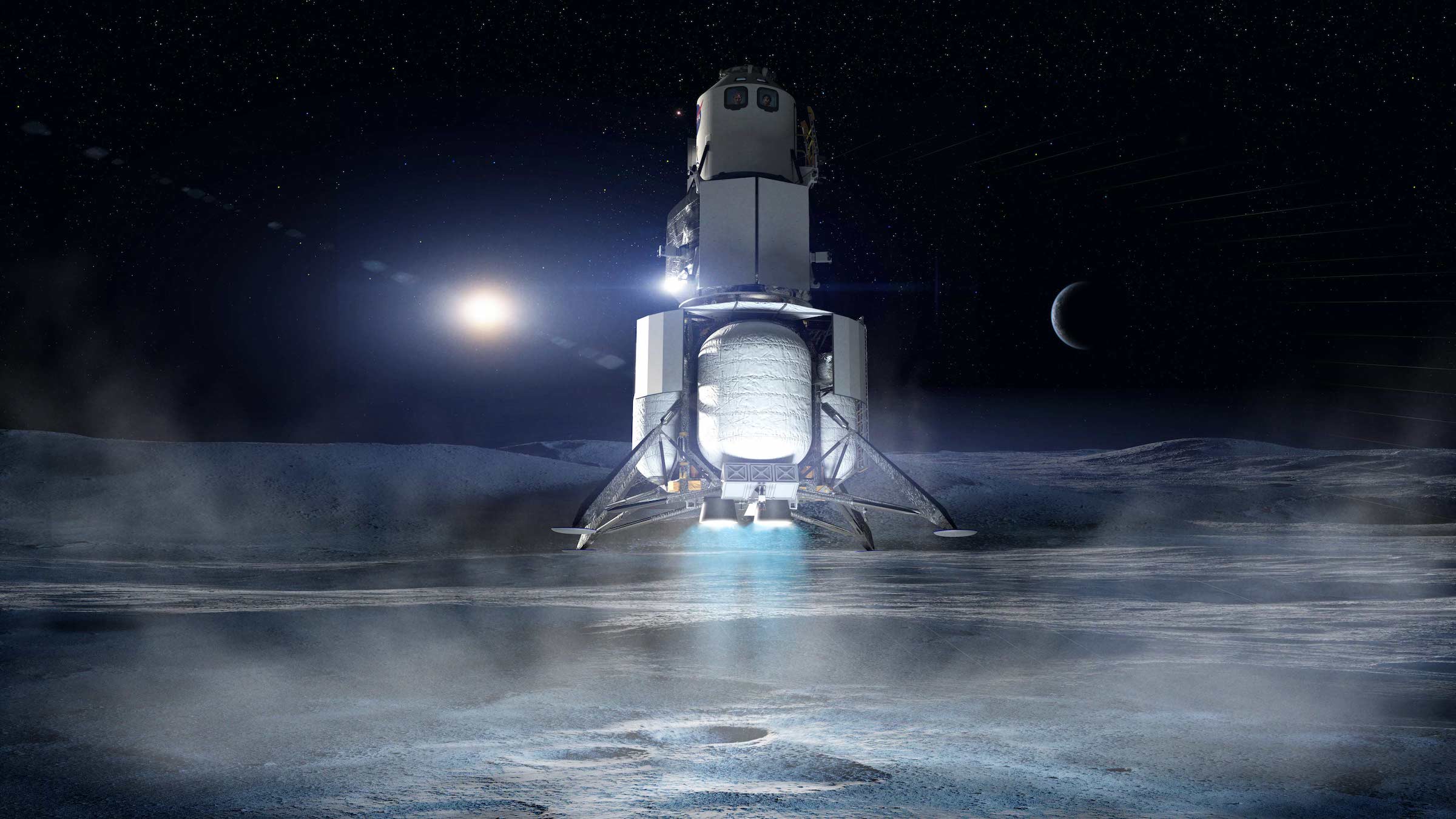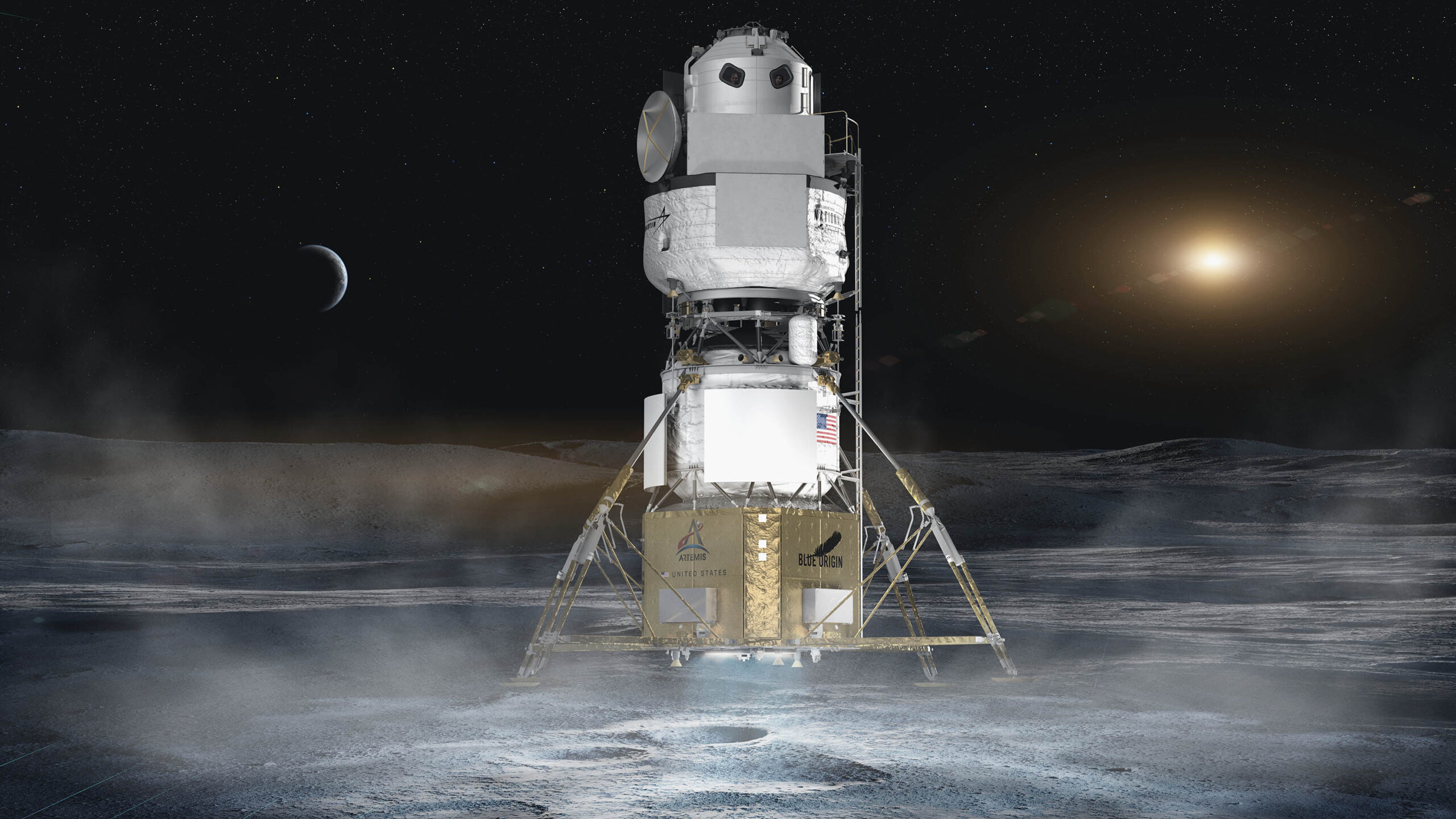
A Closer Look At Blue Origin & The HLS National Team
With NASA headed back to the Moon, they are working on a long list of things that need to be completed prior to any mission. Rather than do it all themselves, the agency is working with private companies in different ways including developing a Human Landing System. This is a vital piece of technology that helps transport humans from the surface of the Moon, up to the Gateway space station.
Blue Origin a part of the National Team, designed and developed a human landing system for future missions to the Moon apart of Artemis. However, it has not gone their way as NASA ended up picking SpaceX and Starship as the best option. Blue Origin disagreed with this decision arguing that their HLS was safer, lower risk, cheaper, and more. Here I will go more in-depth into the features of this landing system, along with Blue Origin’s opinion of Starship, NASA’s decision, and more.
In the past and recently Blue Origin has received a lot of negative attention due to lawsuits being filed. This was no exception to NASA’s decision for the HLS contract. NASA ended up providing many reasons for why they picked SpaceX, but Blue Origin was not satisfied. The company has even created graphics showing all the downsides and dangers of picking SpaceX’s Starship.
HLS Background

Blue Origin along with the National Team, has worked to develop and present their Human Landing System idea for future missions to the Moon. The National Team consists of Blue Origin, Lockheed Martin, Northrop Grumman, and Draper. Together they work with more than 200 companies across 47 states. This team brings decades of experience with human space flight systems, launch vehicles, propulsion, orbital logistics, deep-space missions, interplanetary navigation, and planetary landings. Within this team, each company plays a specific role related to HLS.
Blue Origin, as prime contractor, leads the program management, systems engineering, safety and mission assurance, and mission engineering while providing the Descent Element that is based on the multi-year development of the Blue Moon lunar lander and its BE-7 engine. Lockheed Martin develops the reusable Ascent Element and leads crewed flight operations and training, leveraging Orion spacecraft flight heritage. Northrop Grumman provides the Transfer Element that brings the landing system down toward the Moon based on their Cygnus system, which has flown 13 resupply missions to the ISS. Finally, you have Draper who leads descent guidance and flight avionics, leveraging their crew-rated algorithms demonstrated on previous NASA exploration missions.
National Team HLS Features
Descent Element – Looking at the National Team’s Human Landing System, it’s comprised of three main sections. Starting at the very bottom you have the descent element. Blue Origin is providing the Descent Element that is based on the Blue Moon cargo lunar lander and its BE-7 engine, which have been in development for three years. Variants can meet a range of delivery capabilities for both crew and cargo anywhere on the Moon’s surface, including the lunar South Pole. Blue Origin mentions the lander’s autonomy, guidance, vertical landing architecture, powerful and throttleable liquid engines, and lean operations, all make it stand out from other options. In addition, Blue Origin leverages technologies developed and in service on New Shepard.
Ascent Element – The next major element positioned right above the descent element is the ascent element. Lockheed Martin is providing the crewed Ascent Element and is leading the crewed flight operations and training. The Ascent Element draws heavily from Lockheed Martin’s experience developing NASA’s Orion spacecraft, from direct build-to-print items to multiple common subsystems.
Transfer Element – The last main part of the Human Landing System is the transfer element. Northrop Grumman provides the Transfer Element that brings the landing system down toward the Moon, maximizing delivered mass for both crew and cargo. The Transfer Element is based on its Cygnus cargo module, which has flown 13 resupply missions to the International Space Station.
SpaceX HLS Comparison & NASA’s Decision

The National Team was up against two main companies for the contract from NASA. These two companies were SpaceX and Dynetics. All of which had vastly different proposals and offers for NASA. Once submitted the agency went over all three options and gave each a rating based on different important factors. Specifically, this included a technical rating, management rating, cost, etc. Starting with the technical rating, Blue Origin was rated acceptable, Dynetics was marginal, and SpaceX was acceptable. Looking at the management rating, Blue Origin was very good, Dynetics was very good, and SpaceX was outstanding. Looking at cost, NASA pointed out in their source selection statement that SpaceX’s option was by far the cheapest.
The document specifically said “SpaceX’s Total Evaluated Price of $2,941,394,557 was the lowest among the offerors by a wide margin. Blue Origin’s Total Evaluated Price was significantly higher than this, followed by Dynetics’ Total Evaluated Price, which was significantly higher than Blue Origin’s.” Based on these main factors along with many others, NASA ended up choosing SpaceX as the best option. Blue Origin was not happy about this decision and filed multiple lawsuits against the agency along with making an infographic depicting why SpaceX’s Starship HLS was such a bad decision. The infographic tries to highlight how dangerous and risky choosing SpaceX was. Blue Origin along with the National Team try to highlight how safe and simple their design is in comparison. However, the lawsuits ended up not going in Blue Origin’s favor and the decision stayed the same.
Blue Origin and the National Team point out additional benefits to their design focusing on competition and sustainability. Blue Origin mentions that success hinges on redundancy and that landing astronauts on the Moon is hard. By embracing redundancy through a second lunar lander provider, America increases its chances of returning to the Moon as soon as possible. In addition, they mention, the National Team’s approach to long-term sustainability focuses on reusability to increase affordability. More capable and longer missions to more locations on the surface will enable permanent, sustained surface operations, habitation, and development of lunar resources.
Looking at the conclusion of NASA’s Source Selection Statement helps explain their decision. It says “In light of the three HLS Option A offerors’ evaluation results and in consideration of NASA’s available funding, it is my determination that the award of a single Option A (SpaceX) contract is in the best interests of the Agency. This contract award is the catalyst for developing a critical element needed for the initial Artemis missions.” NASA was confident with their decision based on many different factors and it eventually held up in court as well.
Conclusion
Blue Origin, a part of the National Team, worked to develop a high-quality Human Landing System for future missions to the Moon apart of Artemis. NASA offered multiple companies and teams a large contract for this system that they would compete for. The National Team’s design consisted of a descent element, ascent element, and transfer element all built by a different company. They focused on simplicity and tested flight hardware to get the job done. In the end, NASA ended up picking SpaceX’s design due to cost, technical, and management factors. Blue Origin fought this decision but nothing ended up coming from it. We will have to wait and see what the future holds for the National Team’s Human Landing System and the impact it has on the future of the space industry.
